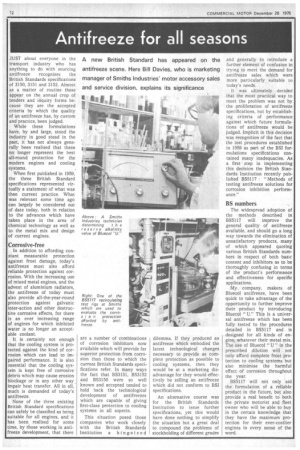Antifreeze for all seasons
Page 14

If you've noticed an error in this article please click here to report it so we can fix it.
A new British Standard has appeared on the antifreeze scene. Here Bill Davies, who is marketing manager of Smiths Industries' motor accessory sales and service division, explains its significance JUST about everyone in the transport industry who has anything to do with sourcing antifreeze recognises the British Standards specifications of 3150, 3151 and 3152. Almost as a matter of routine these appear on the annual crop of tenders and inquiry forms because they are the accepted criteria by which the quality of an antifreeze has, by custom and practice, been judged.
While these formulations have, by and large, stood the industry in good stead in the past, it has not always generally been realised that these no longer represent the best all-round protection for the modern engines and cooling systems.
When first published in 1959, the three British Standard specifications represented virtually a statement of what was then current practice. What was relevant some time ago can largely be considered out of date today, both in relation to the advances which have taken place in the area of chemical technology as well as to the metal mix and design of current engines.
Corrosive-free
In addition to affording constant measurable protection against frost damage, today's antifreeze must also afford reliable protection against corrosion. With the increasing use of mixed metal engines, and the advent of aluminium radiators, the antifreeze of today must also provide all-the-year-round protection against galvanic inter-action and other destructive corrosive effects, for there is an ever increasing range of engines for which inhibited water is no longer an acceptable coolant.
It is certainly not enough that the cooling system is protected against the kind of corrosion which can lead to impaired performance. It is also essential that the cooling system is kept free of corrosive debris which may cause erosion blockage or in any other way impair heat transfer. All in all, much is demanded of today's antifreeze.
None of the three existing British Standard specifications can safely be classified as being suitable for all engines, and it has been realised for some time, by those working in antifreeze development, that there are a number of combinations of corrosion inhibitors now available which will provide far superior protection from corrosion than those to which the current British Standards specifications refer. In many ways the fact that BS3151, BS3152 and BS3150 were so well known and accepted tended to hold back the technological development of antifreezes which are capable of giving first-class protection to cooling systems in all aspects.
This situation posed those companies who work closely with the British Standards Institution a k i'n g-s ized dilemma. If they produced an antifreeze which embodied the latest technological changes necessary to provide as complete protection as possible to cooling systems, then they would be at a marketing disadvantage for they would effectively be selling an antifreeze which did not conform to BSI specifications.
An alternative course was for the British Standards Institution to issue further specifications, yet this would have done nothing to simplify the situation but a great deal to compound the problems of stockholding of different grades and generally to introduce a further element of confusion in trying to meet the demand for antifreeze sales which were more particularly suitable to today's needs.
It was ultimately decided that the most practical way to meet the problem was not by the proliferation of antifreeze specifications, but by establishing criteria of performance against which future formulations of antifreeze would be judged. Implicit in this decision was recognition of the fact that the test procedures established in 1959 as part of the BSI formulations specifications contained many inadequacies. As a first step in implementing this decision the British Standards Institution recently published BS5117 : "Methods of testing antifreeze solutions for corrosion inhibition performance."
BS numbers
The widespread adoption of the methods described in BS5117 will improve the general quality of antifreeze available, and should go a long way towards the elimination of unsatisfactory products, many of which appeared quoting various British Standards numbers in respect of both basic content and inhibitors as to be thoroughly confusing in terms of the product's performance and effectiveness for specific applications.
My company, makers of Bluecol antifreeze, have been quick to take advantage of the opportunity to further improve their product by introducing Bluecol "U." This is a universal antifreeze which has been fully tested to the procedures detailed in BS5117 and is designed for all kinds of engine, whatever their metal mix. The use of Bluecol " U " in the prescribed dilution will not only afford complete frost protection to cooling systems but also minimise the harmful effect of corrosion throughout the year.
BS5117 will not only aid the formulation of a reliable product in the future, but also provide a real benefit to both the private motorist and fleet owner who will be able to buy in the certain knowledge that they have the maximum protection for their ever-costlier engines in every sense of the word.




















































